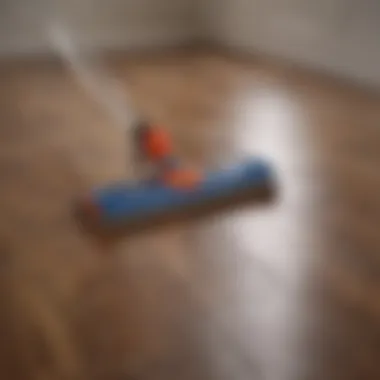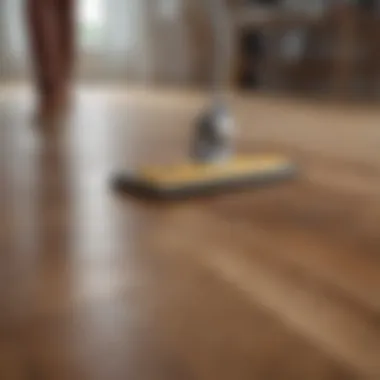Ultimate Guide to Cleaners for Laminate Floors


Intro
Maintaining laminate wood floors requires the right knowledge about cleaning products and methods. Laminate flooring is popular in both residential and commercial spaces for its aesthetic appeal and durability. However, without proper care, its charm can fade over time. This guide explores various cleaners available in the market, their effectiveness, pros and cons, and DIY alternatives.
Homeowners often overlook the importance of using specific cleaners tailored for laminate surfaces. Choosing the wrong product could damage the finish or lead to water damage. Therefore, understanding the options available is crucial. This article aims to equip readers with the necessary information to keep their laminate floors in excellent condition, ensuring longevity and allure.
We will cover both commercial cleaners and homemade solutions, providing practical insights for effective maintenance. This approach serves to enrich the knowledge of homeowners and design enthusiasts alike, ensuring that they can make informed decisions about caring for their laminate floors.
Cleaners for Laminate Wood Floors
When selecting cleaners for laminate wood floors, it is essential to consider their formulation. Not every cleaner is suitable for laminate surfaces. Here, we explore the primary categories of cleaners available:
- Commercial Cleaners: These products are specifically formulated for laminate floors and typically contain gentle cleaning agents. They are easy to use and deliver instant results.
- DIY Solutions: Making your cleaning solution offers flexibility and often uses readily available ingredients.
- Natural Cleaners: These typically do not contain harsh chemicals and are more environmentally friendly.
- Advantages: Ready-to-use, effective on common stains, and often come with additional features like anti-static properties.
- Disadvantages: Some products may contain chemicals that could be harmful over time.
- Common Ingredients: White vinegar, water, and dish soap can create a gentle yet effective cleaner.
- Benefits: Cost-effective and can be tailored to personal preferences.
- Pros: Safe for pets and children and less likely to cause harm to sensitive flooring materials.
- Cons: May require more effort in terms of application and results might vary.
Conclusively, the choice of cleaner will greatly influence the upkeep of laminate wood floors. Understanding the options and their implications enables homeowners to maintain not only cleanliness but also the overall quality of their flooring.
Understanding Laminate Wood Flooring
Understanding laminate wood flooring is essential. This knowledge sets a foundation for how to care for these surfaces properly. Many people are attracted to laminate flooring for its aesthetic appeal and practical benefits. Therefore, it is imperative to have a clear comprehension of its structure and application.
Composition of Laminate Floors
Laminate flooring is engineered from multiple layers. These layers come together to form a durable and resilient surface. The core layer typically consists of high-density fiberboard (HDF). This core provides stability and strength. On top of the core, there is a photographic layer. It’s this layer that gives laminate floors their attractive appearance, mimicking wood or tile patterns.
The topmost layer is a transparent protective coating. This final layer enhances durability and makes the laminate resistant to scratches and fading. Understanding this composition helps when choosing cleaning products, as it is crucial to use those that are gentle yet effective, preserving the floor’s finish.
Common Uses of Laminate Flooring
Laminate flooring is versatile. It can be used in various settings including residential and commercial spaces. Many homeowners choose laminate for living rooms, kitchens, and bedrooms. Its affordability and ease of installation make it appealing.
In commercial environments, such as offices and retail spaces, laminate flooring is often preferred for its durability and easy maintenance. Schools and public buildings also benefit from laminate due to its resistance to heavy foot traffic.
Benefits of Laminate Wood Floors
The benefits of laminate wood floors are significant. They are generally more cost-effective compared to solid wood options. This affordability makes it accessible for a wider range of budgets.
One notable advantage is ease of maintenance. Laminate floors typically require less upkeep than other flooring types. They resist stains and can withstand moisture better than traditional hardwood.
Additionally, laminate floors offer an eco-friendly choice. Many manufacturers produce laminate floors from recycled materials.
The Importance of Proper Cleaning
Maintaining laminate wood floors requires more than the occasional sweep or dusting. Proper cleaning is vital for both preserving the integrity of the flooring and ensuring a healthy living environment. Regular cleaning prevents dirt buildup and scratches that can diminish the appearance and longevity of the laminate. It is crucial for homeowners and design enthusiasts to understand the implications of neglecting this aspect.
Impact on Longevity
The lifespan of laminate wood floors largely depends on cleaning practices. When dirt and grime accumulate, they can act like sandpaper on the floor surface, resulting in scratches and dullness. It is essential to use appropriate cleaners that do not contain harsh chemicals, which can break down the protective layer.
Some key factors influencing longevity include:
- Type of cleaner: Mild, pH-balanced cleaners are often recommended.
- Frequency of cleaning: Routine cleaning helps mitigate long-term damage.
- Immediate response: Addressing spills and stains quickly can prevent permanent marks.


Investing time in maintaining the floors can lead to an extended life, saving costs on repairs or replacements in the future.
Maintaining Aesthetic Appeal
In addition to functional benefits, proper cleaning preserves the aesthetic qualities of laminate floors. Clean and shiny floors enhance the overall appearance of a space, contributing to a welcoming and polished atmosphere. Dirt, dust, and smudges can detract from the floor’s finish, leading to a less desirable look.
Homeowners often seek specific outcomes like:
- Shininess: A well-maintained floor reflects light better, improving the room's ambiance.
- Consistent finish: Regular cleaning prevents staining and discoloration.
- Presentation: Clean floors create an impression that reflects the homeowner's attention to detail.
Keeping your laminate floors clean means they remain an attractive feature of your home, boosting its overall value and appeal.
Health Considerations
The health implications of cleaning practices cannot be overlooked. Dust and allergens can accumulate in neglected spaces, leading to respiratory issues or other health concerns for residents. Safe and effective cleaning solutions can help eliminate such problems while ensuring a healthy indoor environment.
Considerations include:
- Allergen reduction: Regular cleaning minimizes dust, pet dander, and other allergens.
- Non-toxic solutions: Selecting eco-friendly products ensures safety for children and pets.
- Prevention of mold: Keeping floors dry and clean reduces the risk of mold growth, which can cause health issues.
Types of Cleaners for Laminate Floors
Understanding the various types of cleaners for laminate floors is pivotal for maintaining their quality and appearance. Laminate flooring, while resilient, requires specific care to prevent damage over time. Cleaning choices directly affect the look and lifespan of these floors. Selecting the appropriate cleaner involves knowledge about its components, application methods, and the potential impact on health and the environment.
Commercial Cleaners
As the name suggests, commercial cleaners are store-bought solutions designed specifically for laminate flooring. Their formulations typically incorporate a blend of cleaning agents targeted at effectively removing dirt, stains, and other residues.
Ingredients to Look For
When selecting a commercial cleaner, it is critical to examine the ingredients. Look for pH-balanced formulas as they are gentle on floors yet effective against grime. Ingredients such as non-toxic surfactants and ammonia-free compounds contribute to safe usage while still delivering cleaning power. Avoiding products with harsh chemicals is essential. Some common harmful components can ruin the floor's finish, leading to deterioration. Favor products that are specifically marked as safe for laminate surfaces.
Popular Brands and Their Efficacy
Several brands have established a reputation for their effective cleaners. For instance, Bona and Zep both produce solutions that consumers trust for cleaning laminate wood floors. Bona’s formula is often noted for its streak-free finish, while Zep is recognized for its ability to tackle tougher stains and maintain shine. However, efficacy may depend on specific cleaning needs, such as frequency of use and types of stains encountered.
Eco-Friendly Options
The rise in environmental awareness has led to a variety of eco-friendly commercial cleaners. Products with plant-based ingredients and biodegradable components are increasingly available. These cleaners serve dual purposes: effective cleaning and reduced environmental impact. Brands like Method and Seventh Generation are well-known for offering these alternatives while ensuring their products are safe for home use. Keep in mind, though, that eco-friendly options may be somewhat less aggressive against stubborn stains, which is a consideration for those with highly trafficked areas.
DIY Cleaning Solutions
For those who prefer an economical approach, DIY cleaning solutions can be equally effective as commercial products. These home-made mixtures often use common household items, making them not only cost-effective but also safer for the environment.
Vinegar and Water Mixture
One popular DIY solution is a vinegar and water mixture. Utilizing a ratio of one cup vinegar for every gallon of water, this mixture can detoxify surfaces without harsh chemicals. Vinegar acts as a natural disinfectant while being non-toxic and gentle on the laminate. However, avoid using excessive amounts of vinegar as the acidity can damage the floor’s finish over time if used frequently.
Baking Soda and Water Paste
Another effective and easy solution is a baking soda and water paste. Mixing baking soda with water creates a gentle abrasive that can assist in scrubbing out stubborn stains without scratching the surface. It is an accessible method for creating a safe cleaner at home. However, users must ensure to use it sparingly, as excessive scrubbing may harm the laminate surface if not done properly.
Essential Oil Additions
Adding a few drops of essential oils to any cleaning solution can provide a pleasant scent while improving cleaning power. Oils like tea tree or lemon not only smell fresh but also possess natural antibacterial properties. Though beneficial, essential oils should be used in moderation as they can leave a residue if used excessively.
It is important to test any DIY cleaning solution on an inconspicuous area of the floor before applying it widely. This helps ensure it does not alter the floor's appearance.
How to Choose the Right Cleaner


Selecting an appropriate cleaner for your laminate wood flooring is crucial. Each floor finish and level of usage requires a tailored approach. A well-chosen cleaner enhances the floor’s longevity and preserves its visual allure, contributing positively to the overall environment within your home.
Consider Your Floor's Finish
The finish on laminate flooring significantly influences how to approach cleaning. Floors with a glossy finish tend to show dirt and scratches more clearly. They may require gentle cleaners to avoid diminishing their shine. On the other hand, floors with a matte finish are often more forgiving; however, they can still be susceptible to damage from harsh chemicals. Understanding the specific finish on your laminate flooring helps determine the right cleaning product to use.
When evaluating cleaners:
- Gentle Formulations: Look for those marketed for shiny surfaces to protect the gloss.
- pH Neutral Options: Products that are pH balanced are typically safer and effective.
- Non-Abrasive Solutions: Avoid anything that contains grit; it can scratch even the toughest finishes.
Assessing Foot Traffic and Usage
The durability needs of laminate floors greatly depend on foot traffic. High foot traffic areas, such as hallways and living rooms, require more robust cleaning solutions to deal with dirt and potential scuff marks. If your laminate floor receives heavy usage, consider products specifically designed to tackle such requirements.
Key considerations include:
- Frequency of Cleaning: High traffic areas may need frequent cleaning. Select a cleaner that suits routine use without causing damage.
- Type of Soil: Areas that collect more dirt will benefit from deeper cleans. A heavy-duty cleaner can be effective here, rather than a gentle one.
- Plain and Simple Materials: Stick to products that don't promise too much; they can simplify the routine.
Evaluating Chemical Sensitivities
The choice of cleaner must also take into account potential sensitivities of individuals in the home. If there are young children or pets, or if a household member suffers from allergies, opting for eco-friendly or non-toxic solutions is vital. This requires careful scrutiny of product labels to ensure safety.
Here are considerations when selecting:
- Ingredients: Opt for safe, biodegradable ingredients that don’t compromise health.
- Fragrances: Many conventional cleaners use strong scents that may irritate sensitive individuals. Choosing fragrance-free options can minimize discomfort.
- Allergy Testing: If unsure, testing a small area can help identify any adverse reactions.
Maintaining laminate flooring is more than about keeping it clean; it is about choosing the right cleaner wisely. This ensures the value and appeal of your flooring are respected and preserved. Thus, knowing the nature of your laminate and usage patterns significantly aids in making a well-informed choice.
Application Techniques
Proper application techniques for laminate wood floor cleaners are essential to ensure effective cleaning without damaging the flooring. Understanding how to prepare your space for cleaning and the best practices when applying cleaners can greatly impact the longevity and appearance of your floors. These techniques help prevent common issues that arise from improper cleaning methods, making it a crucial aspect of floor maintenance.
Preparation Before Cleaning
Remove Loose Debris
The act of removing loose debris is fundamental to maintain the integrity of laminate wood floors. Dust, dirt, and small particles can create scratches when cleaning, compromising the floor's appearance over time. A key characteristic of this preparation step is its simplicity; often it just requires a broom or a vacuum. It makes this choice beneficial as it forms the first line of defense against grime and particles that may become embedded into the surface.
A unique feature of removing loose debris is its immediate impact. By doing this, you minimize the need for intensive cleaning later. However, if overlooked, the accumulation of debris can lead to greater damage requiring more costly repairs. Thus, making this a routine task is paramount in any cleaning schedule.
Avoiding Excess Water
Avoiding excess water is another crucial consideration when cleaning laminate floors. These surfaces can be sensitive to moisture, which could seep into seams and lead to warping or swelling. A key characteristic of this approach is its focus on maintaining the floor's structure; by using minimal moisture, you protect the floor from potential long-term damage.
This choice is particularly beneficial as it allows for effective cleaning without the risks associated with excess water. A unique aspect of this practice is the use of damp mops or microfiber cloths, which can clean effectively without leaving puddles. However, failing to regulate water usage can result in irreversible damage, underscoring the importance of this technique in the overall maintenance strategy.
Best Practices for Application
Using Mops vs. Cloths
The choice between mops and cloths can affect the cleaning efficiency and the condition of your laminate floor. Mops often cover larger areas quickly, making them a popular option for extensive spaces. They allow for a broader application of cleaner, which can be seen as advantageous when tackling large sections. However, improper mopping can lead to the floor getting oversaturated, which poses a risk.
Cloths, on the other hand, provide greater control and precision. This choice is particularly effective in corners and around furniture. The downside may include increased time spent cleaning smaller areas, but the benefit of better care for your flooring often outweighs the downsides.
Appropriate Cleaning Methodology
The methodology you choose when cleaning laminate wood floors significantly influences the outcomes you attain. A fundamental consideration should be the type of cleaner used; this decision is based on the level of grime and the type of finish on your floor. Specific methodologies, such as using circular motions or following the grain of the floor, can help achieve a more thorough clean.


One unique feature of this approach is its adaptability. By tailoring the cleaning method to the particular needs of your floor, you can enhance its appearance efficiently. However, if the methodology is too aggressive, you may inadvertently scratch the surface. Therefore, balancing effective cleaning with care is vital for achieving the desired results.
Common Mistakes in Laminate Cleaning
Proper cleaning of laminate floors is crucial for maintaining their condition and longevity. However, many homeowners make errors during the cleaning process that can lead to unwanted damage or deterioration of their laminate surfaces. Recognizing these common mistakes can help in preserving the aesthetic appeal and functionality of the floors. This section will detail the most prevalent missteps, providing insight into how they affect laminate wood flooring.
Using Wrong Cleaners
Selecting an appropriate cleaner is essential for the effective maintenance of laminate floors. Many individuals often opt for general-purpose cleaners that are not formulated for laminate surfaces. These products could contain harsh chemicals that might strip away the protective layer or leave behind residues that attract dirt.
Using cleaners intended for hardwood or tile surfaces can also pose a risk. For instance, oil-based cleaners can create a slippery surface and make laminate floors hazardous, especially in high-traffic areas. Therefore, it is crucial to choose cleaners explicitly meant for laminates. Look for labels that indicate compatibility with laminate wood surfaces. Knowledge of suitable products can prevent premature wear and staining.
Excessive Water Usage
Another frequent mistake is the overuse of water during cleaning. Laminate flooring is engineered with a core that can be compromised by excess moisture. If too much water is applied during cleaning, it can seep into the seams and edges of the laminate, leading to swelling and warping. This occurs especially if the cleaning method involves mops that do not adequately wring out the water.
To mitigate this issue, it is advisable to use a damp mop rather than soaking the floors. Make sure the mop is only slightly damp, and avoid poured or sprayed water directly onto the surface. By being mindful of water usage, you can effectively maintain the structural integrity of the laminate flooring while ensuring it remains clean and visually appealing.
Neglecting Regular Maintenance
Routine maintenance is a fundamental aspect of keeping laminate floors in good condition. However, many homeowners tend to overlook regular cleaning schedules or assume that infrequent cleaning is sufficient. Neglecting routine maintenance can lead to the accumulation of dirt, dust, and other debris that could dull the surface finish and even lead to scratches.
Establishing a regular schedule for cleaning laminate floors is essential. Incorporate gentle sweeping or vacuuming as part of your weekly upkeep to prevent dirt buildup. Additionally, periodic deep cleaning with appropriate laminate cleaners will protect against wear. Adopting a consistent maintenance routine not only improves the appearance of the floors but also prolongs their life.
Regularly maintenance protect your investment in laminate flooring. Be proactive to enhance its durability and aesthetics.
Understanding these common mistakes can greatly enhance your laminate flooring experience. By choosing the right products, managing water usage, and committing to regular upkeep, you can achieve a beautiful and long-lasting floor.
Maintaining Your Laminate Floors
Maintaining laminate floors is essential for preserving their beauty and functionality over time. Regular upkeep not only prolongs the life of the flooring but also ensures that its appearance remains fresh and inviting. Investing time in maintenance can lead to significant savings by reducing the need for repairs or replacements. Moreover, well-maintained floors contribute to overall home aesthetics, impacting both personal enjoyment and property value.
Routine Cleaning Schedule
Establishing a routine cleaning schedule is crucial for laminate floor maintenance. A consistent cleaning routine helps to prevent dirt buildup, which can harm the floor's surface. Aim to sweep or vacuum the floor at least once a week to remove loose debris. Mopping should occur bi-weekly using a cleaner specifically designed for laminate surfaces. This preventive approach minimizes scratches and helps to maintain the shine of the floor. If there are spills, wipe them immediately to prevent stains or moisture damage.
Preventative Measures
Taking preventative measures can save considerable effort in the long run. Simple actions can greatly protect laminate flooring from wear and tear.
Using Area Rugs
Using area rugs can significantly reduce wear on your laminate flooring. They serve as barriers against dirt, moisture, and scratches caused by foot traffic. The key characteristic of area rugs is their ability to absorb impact, protecting the floor underneath. This makes them a beneficial choice for high-traffic areas, where laminate is most likely to suffer damage. However, it is vital to ensure the rugs have non-slip backings to prevent accidents.
Advantages of area rugs include their versatility in design, allowing homeowners to express personal style while providing protection. Disadvantages may include the need for frequent cleaning and potential slipping if not secured properly.
Implementing Floor Mats
Implementing floor mats at entry points is another effective strategy for maintaining laminate floors. The key characteristic of floor mats is their capacity to trap dirt and moisture before it enters the living space. This is particularly beneficial during rainy or snowy seasons, as it can prevent tracked-in debris that damages the floor's finish.
Floor mats come in various materials, offering unique features. For instance, rubber mats are excellent at keeping dirt locked in, while fabric mats can add aesthetic appeal. The advantages of using floor mats include significantly reduced cleaning efforts and enhanced durability of the flooring. However, the downside may involve the regular need for washing and replacement to keep them effective and visually appealing.
"Regularly maintained laminate floors not only enhance the interior decor but can also increase property value."
Ending
When choosing a cleaner, consider the specific finish of your laminate. Not all cleaners suit every type of finish. It’s also important to assess foot traffic levels. High-traffic areas may require more robust cleaning solutions compared to low-traffic zones.
Health considerations cannot be overlooked either. Many commercial cleaners contain chemicals that may trigger sensitivities or allergies. Therefore, eco-friendly options are worth exploring. They provide a safe alternative without compromising on cleanliness.
Among the benefits discussed, a regular cleaning routine stands out. It prevents damage and ensures your floors retain their shine. Incorporating preventive measures, like area rugs and floor mats, also contributes to the floors’ longevity. These simple strategies make a significant impact on maintaining the quality of your laminate.
"Investing time in proper maintenance now saves costs in repairs or replacements later."
Ultimately, clean laminate wood floors enhance the aesthetic appeal of any space, making it feel welcoming and well-cared for. By applying the insights from this guide, individuals can create a practical cleaning regimen that suits their unique needs.







